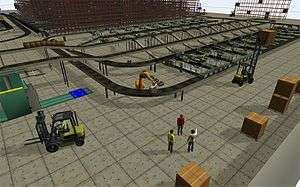Flexsim
 | |
| Developer(s) | FlexSim Software Products, Inc. |
|---|---|
| Stable release |
16.2.1
/ October 2, 2016 |
| Operating system | Windows 10/Windows 8/Windows 7/Windows Vista/Windows XP |
| License | Proprietary |
| Website | www.flexsim.com |
FlexSim is a discrete event simulation software package developed by FlexSim Software Products, Inc. The FlexSim product family currently includes the general purpose FlexSim product and FlexSim Healthcare (FlexSim HC).
History
FlexSim was founded in 1993 by Bill Nordgren (Co-Founder Promodel Corporation, 1988), Roger Hullinger, and Cliff King, originally under the name F&H Simulations, Inc. F&H Simulations sold, supported, and conducted training courses for Taylor II simulation software[1] – owned and developed by Holland's F&H Simulation B.V (F&H Holland). In 1998, F&H Holland developed the first generation 3D object oriented simulation engine Taylor ED (Enterprise Dynamics). F&H Simulations assisted with the development of robust objects for use in Taylor ED. In 2000, F&H Holland was acquired, F&H Simulations became independent, and a new simulation product started development under the guidance of Dr. Eamonn Lavery and lead programmer Anthony Johnson. This new 3D simulation product, known now as FlexSim, coincided with F&H Simulations, Inc. changing its name to FlexSim Software Products, Inc.[2] FlexSim 1.0 was released in February 2003 and the software has been in constant development since then. FlexSim HC was later developed to simulate and improve healthcare systems.
FlexSim Software Products, Inc. is headquartered in Orem, Utah, USA, with offices in Canada and Mexico. The FlexSim distributor network has offices in 34 countries and serves users worldwide.[3]
Application and uptake
As general purpose simulation software, FlexSim is used in a number of fields:
- Manufacturing:[4] Production, assembly line, job shop, etc.
- Material handling: Conveyor systems, AGV, packaging, warehousing
- Logistics and distribution:[5] Container terminal operation, supply chain design, distribution center work flow, service and storage layout, etc.
- Transportation:[6] Highway system traffic flow, transit station pedestrian flow, maritime vessel coordination, custom traffic congestion, etc.
- Others: Oil field or mining processes, networking data flow,[7] etc.
Main features
Robust standard objects
FlexSim includes a standard object library, with each object containing pre-built logic and task execution to mimic the resources found in real-world operations. FlexSim objects[8] are defined and programmed in four classes: fixed resource class, task executer class, node class and visual object class. FlexSim uses an object-oriented design.
Logic building tools
The logic for a FlexSim model can be built using very little or no computer code. Most standard objects contain an array of drop-down lists, properties windows, and triggers that allow the user to customize the logic required for an accurate model of the system. FlexSim also includes a flowcharting tool to create the logic for a model using pre-built activity blocks.
Drag-and-drop controls
Users can build the model by dragging and dropping predefined 3D objects into a "model view" to layout and link the model. Experienced users also have the option to specify and modify object parameters and behaviors using FlexScript and C++ programming languages.[9]
See also
References
- ↑ William B. Nordgren. "Taylor II manufacturing simulation software". In Proceedings of the 27th Conference on Winter Simulation, IEEE Computer Society, Washington, DC, 401–404, 1995.
- ↑ "About Us - FlexSim Simulation Software". FlexSim Simulation Software. Retrieved 2016-10-24.
- ↑ "Contact - FlexSim Simulation Software". FlexSim Simulation Software. Retrieved 2016-10-24.
- ↑ Erol Gelenbe, Hatim Guennouni, "FlexSim: A flexible manufacturing system simulator", European Journal of Operational Research, Volume 53, Issue 2, July 25, 1991, Pages 149–165.
- ↑ Liu, Miaomiao; Dong, Mingwang (2008). "The Simulation Technology of Port Container Logistics System on Flexsim". ASCE Conference Proceeding 330: 2547–2552. doi:10.1061/40996(330)376.
- ↑ Wang Weiping, Zhao Wen, Zhu Yifan and Hua Xueqian, "Survey on the Object oriented Simulation Method", Journal of National University of Defense Technology, 1999-01.
- ↑ Pierre G. Paulin, Faraydon Karim and Paul Bromley, "Network Processors: A Perspective on Market Requirements, Processor Architectures and Embedded S/W Tools", Design, Automation and Test in Europe Conference and Exhibition, p. 0420, 2001.
- ↑ Garrido, Joés M. (2009). Object Oriented Simulation. Springer. ISBN 978-1-4419-0515-4.
- ↑ William B. Nordgren. “Flexible simulation (Flexsim) software: Flexsim simulation environment”, Proceedings of the 35th conference on Winter simulation: driving innovation, 2003.